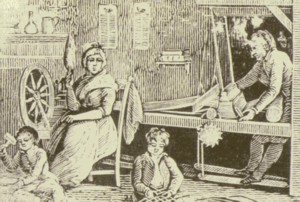|
The Family Economy is a term we use to describe products, goods, and services, mostly produced in the home and where the workforce consists of family members. It is the most basic but most hidden element of the pre-industrial community economy.
As most tasks in pre-industrial society were labor-intensive, The early American workforce suffered from a chronic shortage of labor. Bound (slave, criminal, orphan) and contract labor (indentures and apprentices) only solved part of the problem. Early Albany families were large and all members were expected to work in support of the family's subsistence and commercial activities. Since many families had large numbers of children, they performed many of the most basic tasks on an ongoing basis. Two decades into a marriage, the family economy typically would reach a high point with many children, adolescents, young adults, and even the elderly and infirm efficiently contributing to its production. Almost all families included at least some children who grew up but never married. Physical and emotional reasons answer some of the questions as to "why not?" But younger sons and daughters of large families sometimes remained unmarried even though no health-related impediments are apparent. We believe un-married adult children who lived in their parents' home were a means to bolster the family economy as their experience, loyalty, and simply "extra hands" were great assets to a household's overall well-being [This paragraph is not quite right but the point is valid nonetheless]. first posted 6/20/02; revised 4/28/06 |
 This
senario copied from a woodcut printed in The Little Book of Early
American Crafts and Trades (first
This
senario copied from a woodcut printed in The Little Book of Early
American Crafts and Trades (first